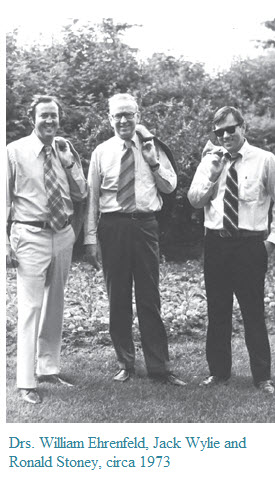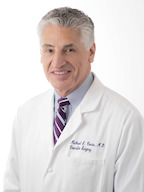The UCSF Division of Vascular and Endovascular Surgery evolved from the education and surgical training program of the Department of Surgery at UCSF. Edwin Jack Wylie, M.D., as a third year resident, was exposed to Norman Freeman, M.D., a pioneer in vascular surgery and chief of the vascular clinic. After completing his residency in 1948, Dr. Wylie began his professional career as a member of the UCSF surgical clinical faculty. He then became a Professor of Surgery and a Vice-Chair of the UCSF Department of Surgery in the 1960s.
Pioneering Vision
In January 1951, Dr. Wylie performed the first aorto-iliac thromboendarterectomy in the U.S. This pioneering effort was highly successful and only one of the many visionary concepts concerning vascular disease and the care of vascular patients that he would introduce. In 1958, a vascular surgical service was established at UCSF, and the general surgery residents were assigned rotations (3-6 months) for specific vascular surgery training.
The Nation's First Fellowship in Vascular Surgery
In 1962, Malcolm Perry M.D. was appointed as UCSF's first Vascular Surgical Fellow and completed an intense one-year training program. During his training, he conducted clinical research in cerebrovascular disease. The UCSF Vascular Surgery fellowship was the first in the U.S. More than 100 fellows have completed their training here, prior to embarking on a career in vascular surgery (more than half are in academic centers, either in the U.S. or abroad).
A Quest for Excellence

The guiding principles that evolved under Dr. Wylie were thoughtful care of the patient, an understanding of vascular disease, developing technical proficiency, and providing training for vascular surgeons. In 1972, Dr. Wylie's presidential address to the International Society of Cardiovascular Surgery was entitled, Vascular Surgery - A Quest for Excellence.
This presentation captured his philosophy - concern for the patient threatened by vascular disease, the complexities of vascular disease and its treatment, and the need to establish training standards and monitor vascular fellowship training programs so that they might provide the highest quality care and treatment for the threatened patients.
Over the next decade, these issues were all adopted and vascular fellowships and certification of vascular trainees became a reality.
Jack Wylie died shortly after receiving the first Certificate of Special Competence in Vascular Surgery - No.1, by the American Board of Surgery, in September 1982.
During the 1980s and 90s, the vascular division continued under the co-direction of Drs. Ronald J. Stoney and William Ehrenfeld, members of the UCSF surgical faculty and Dr. Wylie's partners. They emphasized and continued the strong fellowship training program, developed innovative operative treatments of complex vascular problems, and published cutting edge clinical research.
VascularCures - The Foundation for Accelerated Vascular Research
In 1982, Drs. Stoney and Ehrenfeld established VascularCures - The Foundation for Accelerated Vascular Research (then called PVRF), a charitable organization funded through the generosity of grateful patients. VascularCures supports clinical and basic research, and education, all focused on a better understanding and improved treatment of vascular diseases.
Laboratory for Accelerated Vascular Research
In 2001, VascularCures and the Wayne and Gladys Valley Foundation established, and have continuously funded, the Laboratory for Accelerated Vascular Research (LAVR), a new translational vascular science laboratory at UCSF. LAVR is fundamental to the division's mission in providing innovative patient care, comprehensive vascular training, and translational research focused on improved treatments and eventually the ultimate cure, prevention of vascular disease.
Endowed Chairs and Scholarship
Edwin J. Wylie Chair in Vascular Surgery
VascularCures and the faculty of the UCSF Division of Vascular and Endovascualr Surgery launched a campaign to create a Distinguished Chair in honor of Dr. Wylie. Funds for this were raised from grateful patients, UCSF faculty, family and many of his colleagues in the U.S. and around the world. The required capital was raised in several years and transferred to the UCSF Foundation to establish the Edwin J. Wylie Chair in Vascular Surgery. The UCSF Foundation provided prudent investment management and the capital grew while awaiting the first recipient of this award.
Dr. Louis Messina was recruited from the University of Michigan Department of Surgery in 1995. He was named the inaugural Edwin J. Wylie Chair in Vascular Surgery and Professor and Chief of the Vascular Division. A former surgical resident and vascular fellow at UCSF, Dr. Messina continued the emphasis on complex aortic surgical repair and expanded the research commitment in molecular science of vascular disease, with continued support from VascularCures.
Wylie Scholar Award in Academic Vascular Surgery
In 1996, VascularCures established the Wylie Scholar Award in Academic Vascular Surgery to honor of the memory of Dr. Wylie. This multi-year career development award provides promising vascular surgeon scientists in North America funds to support their relevant research discoveries that qualified for national agency funding and established them as independent investigators. In 2005, Rajabrata Sarkar, MD, Ph.D., then an Associate Professor of Surgery at UCSF, was the recipient for the award. Since its inception, 13 scholars have received this distinguished award at 10 institutions spanning North America
Mildred V. Strouss Endowed Chair in Vascular Surgery
 In 2006, the Mildred V. Strouss Endowed Chair in Vascular Surgery was established through a generous gift of the Mildred V. Strouss Charitable Trust. This trust was directed by a thankful patient. Rong Wang, Ph.D., Director of the Laboratory for Accelerated Vascular Research, was named the inaugural holder of the Chair.
In 2006, the Mildred V. Strouss Endowed Chair in Vascular Surgery was established through a generous gift of the Mildred V. Strouss Charitable Trust. This trust was directed by a thankful patient. Rong Wang, Ph.D., Director of the Laboratory for Accelerated Vascular Research, was named the inaugural holder of the Chair.
Advances in Endovascular Therapy
 Timothy Chuter, M.D., a pioneer in the rapidly expanding less invasive endovascular field, was recruited in 1996 from the University of Rochester. He developed the Endovascular Program at UCSF, which included new and innovative therapies, a research program to refine current techniques, and the development and evaluation of new devices, and importantly, a training program.
Timothy Chuter, M.D., a pioneer in the rapidly expanding less invasive endovascular field, was recruited in 1996 from the University of Rochester. He developed the Endovascular Program at UCSF, which included new and innovative therapies, a research program to refine current techniques, and the development and evaluation of new devices, and importantly, a training program.
This division has been an advocate of the modern surgical treatment of aortic disease beginning approximately 50 years ago when endarterectomy and various grafts were used to treat occlusive and aneurysmal disease respectively. As the diagnosis of aortic diseases improved, technical proficiency matched the demands of surgical repair of complex aortic lesions, and comprehensive perioperative care increased the patients' chances for safe treatment and speedy recovery. The expansion of endovascular therapy has furthered the vision of providing secure, effective, and durable treatment of aortic disease.
A Leader in Patient Care
The division, through the seminal publications of its faculty and trainees, has maintained a leadership position in patient care, and vascular training of students, residents, and post-graduate fellows. Technological advances in the last decade have played a major role in revolutionizing our modern comprehensive care of the vascular patient, by the introduction of catheter based endoluminal treatment strategies, to compliment traditional open surgery.
These techniques have crossed traditional boundaries and are unarguably visionary methods, which deliver treatment through the arterial tree rather than requiring traditional, more invasive surgical exposure. The division has a growing endovascular experience including technological research and development of design modification to expand the indications for device utilization. These new less invasive treatment paradigms are safe, effective, and increasingly applicable and only their long-term durability remains to be defined.
Continuing the Tradition of Excellence
 In 2008, Michael S. Conte, M.D., of Brigham and Women's Hospital, was recruited and joined the UCSF Dept. of Surgery as Professor and Chief of the Vascular and Endovascular Surgery Division, succeeding Dr. Louis Messina.
In 2008, Michael S. Conte, M.D., of Brigham and Women's Hospital, was recruited and joined the UCSF Dept. of Surgery as Professor and Chief of the Vascular and Endovascular Surgery Division, succeeding Dr. Louis Messina.
He, like Dr. Messina, brings a strong commitment to sustaining the legacy of the division, through exemplary leadership, innovative treatment strategies, comprehensive training and a translational clinical research program.
Under Dr. Conte's leadership, this tradition of excellence and innovation has continued with the development of safer and less-invasive techniques for treating vascular disease, including an endovascular aneurysm repair program, catheter-based treatment of arterial blockages, and minimally invasive treatments for varicose veins/venous disease.
The Division's research program is a leader in the development of device technology for aneurysms, as well as novel biologic therapies to improve the outcomes of bypass surgery, promote new blood vessel growth, and ameliorate the progression of PAD.